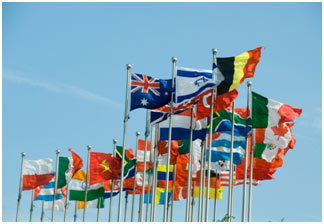Top Stories
International Trademark Law and You: Keeping Your Brand Assets Protected Overseas

The modern world is more dangerous than ever for an unprotected brand asset. A company’s hard-won logos, slogans, characters, and more can easily be poached, distorted, and consumed over the vast global network of the Internet. Fortunately, the United States believes firmly in intellectual property rights, so as long as a company files for protection, it can seek action against American people and groups who infringe on its brand. Unfortunately, that is not the case around the world.

U.S. Trademark Protections
Modern trademark law in the United States is exquisitely simple, which is convenient to American businesses, especially considering the complexity of intellectual property rights. Any person can seek legal security for their brand assets via trademark through the United States Patent and Trademark Office (USPTO). After completing the necessary trademark paperwork and submitting the required fees, the brand asset will be logged and protected under the law. Then, every 10 years or so, one must renew one’s trademark with a similar process.
Most business owners already understand the myriad benefits of trademarking their ideas. Trademark law thwarts competitors and others from besmirching a brand with poor content or false information using certain trademarked concepts. Additionally, it prevents other companies from adopting “confusingly similar” marks that may detract from a company’s ability to do business. Trademarks allow companies to sue infringers for improper use of their brand, thus preserving the integrity of their brand message.
Generally, U.S. trademarks fall under one of three categories, which range in the strength of their protections:
- Arbitrary and fanciful. Companies whose names and brands are distinct from their goods and services — like Apple or Starbucks — should seek arbitrary trademarks. These trademark protections tend to be the strongest.
- Suggestive. Companies who select names reminiscent of their products fall under this trademark category. Usually, suggestive brands require a small leap in thought to recognize the industry, like Playboy Magazine or Whirlpool Appliances. These are somewhat strong trademarks.
- Descriptive. Companies who use the common names of their goods or services to craft their brands receive the weakest trademark protection because other similar companies must have use of these descriptive terms. However, descriptive companies can gain more protection if they demonstrate that the population associates a descriptive term with the company rather than the product.
Current International Guidelines

Through the system, trademark seekers need file only one document, using one language, one set of fees, and one currency to earn brand security in any number of designated countries where the Madrid Protocol is currently in place. Plus, countries (called “contracting parties” under the treaty) have a strict timeline they must follow; if they fail to refuse trademark protection within 18 months of filing, international protections are automatically granted.
Still, the Madrid Protocol does have a few flaws. American companies submit their applications for domestic and international trademarks to the USPTO, who is responsible for accepting and disbursing the trademark. However, if an item on the domestic trademark application (also called the basic registration) is omitted or rejected, it will also be omitted or rejected on the international application, which means that global companies are subject to the discretion of their home governments. A company whose brand is denied international protections in this way has undergone a “central attack,” and though less than half a percent of international registrations have been impacted in this way, it remains a frightening possibility.
Planned Global Regulations
To many, the protections of the Madrid Protocol are outdated and dangerous, which is why plenty of companies are thrilled about the impending Hague System for International Registration of Designs.
At the turn of the century, the Hague Conventions (which derived their name from the seat of government in the Netherlands) became some of the first and most significant treaties outlining international law. Much like the later Geneva Protocol, the Hague discussed appropriate conduct in war and suitable sentences for war crimes. Since then, the Hague has developed an array of private international laws as well, including protections of children and families, guidelines for litigation, and legislation on commerce and finances. The new design registry will be a component of the latter.
Instead of filing applications with the USPTO, under the Hague System, companies seeking international protections can deal directly with the World Intellectual Property Organization (WIPO). Like the Madrid Protocol, a company would need to file only one application (using one language and one currency) but the process is reported to be even simpler, with lower fees and less paperwork. Plus, the Hague offers preliminary protections for trademarks seekers between filing and acceptance, and the duration of a single trademark is extended to 15 years instead of 10. Finally, companies can submit as many as 100 designs for their trademark as long as the designs conform to a single class.
As yet, not all countries have adopted the Hague System, but most prominent European, Asian, and African nations are members. Additionally, since the United States has joined, other major parties, including Canada, Australia, China, and Russia, are expected to succumb to the system. Owning international trademarks is a significant step for any business, but it is a necessary one if your brand is growing into the global economy. Before you expand, you should safeguard your brand assets by following the Hague guidelines against international infringement.

-
Top Stories4 days ago
Sterling wavers as markets gauge reported Israeli attack on Iran
-
Top Stories4 days ago
France orders retailers to display shrinkflation
-
Top Stories4 days ago
Explainer-Bitcoin’s ‘halving’: what is it and does it matter?
-
Top Stories4 days ago
Oil-rich regions in Kazakhstan brace for floods, Siberian rivers burst in Russia







